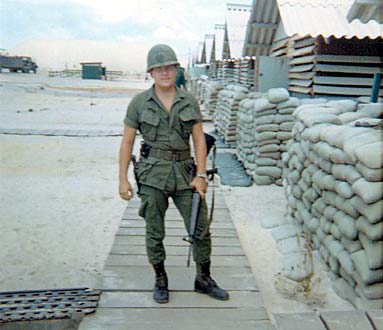
Vietnam Air
Police Police Law Enforcement Shootout! by Ken Boyer |
|
Cam Ranh Bay AB Air Base: On August 30th, 1968, I was assigned machine gun
bunker duty on the bay side of Cam Ranh Bay AB. The bunker
had a mortar pit attached. The night passed and was uneventful.
As morning approached, I was waiting for my ride to take
me back to the hooch where I could get something to eat,
use the
The jeep came to pick me up at approximately 5:30 AM. While riding in the jeep and before the jeep reached the paved road, I unloaded my .38 revolver and M16 rifle. I did this to speed the checking in of my weapons once I had returned to the Security Police Headquarters. I wanted to get to bed and get some sleep. When we finally reached the paved road, I got out of the jeep. I thought I could save time by hitchhiking back to headquarters faster than staying with the jeep. The jeep then turned north to the Korean compound to pick up another Air Policeman. This area was located just a little south and west of the Cam Ranh air terminal. I started to walk south with the idea of hitchhiking. I walked for a distance because there were no vehicles on the road at that early morning hour. Eventually I came upon an Air Force Law Enforcement E5 who had an Army six-by truck stopped. He was talking to the soldier and busy, so I passed by not wanting to interrupt his working. After a little distance, I eventually turned around. When I did, I noticed that the Air Policeman and soldier were fighting in the middle of the road and that the soldier had taken the nightstick away from the sergeant. I watched as the Air Policeman drew his .38 revolver from his holster and pointed it at the soldier. In the middle of the road the soldier dropped the nightstick. When the soldier took a few steps backward, the sergeant was able to retrieve his nightstick and reattach it to his web belt. Having viewed this, I quickly offered my assistance. The sergeant and I ushered the man into the back seat of his covered Air Police vehicle and the sergeant returned his .38 revolver to its holster without strapping it in. I positioned myself beside the jeep passenger door to prevent the individual from escaping. While standing there the soldier and I began to talk. He said, "What am I going to do? Both of you have guns and I don't have one." I replied, "Don't worry, we are all Americans." (We were supposed to be on the same side.) The sergeant, who was standing beside the driver's door, reached into the jeep to retrieve the radio mike positioned on the passenger's side of the dashboard. As he did this, the soldier, who was sitting directly behind the driver's seat, reached up and grabbed the sergeant's .38 out of his holster and pointed it at me. Without any hesitation, he fired. I knew immediately that I had been shot but didn't know where exactly. I could feel the powder burn on my face and hands. I stood there for a few seconds and decided that I needed to do something. I rolled to my right and dropped my M16 rifle. Clutching my abdomen, I fell to my knees. In the movies most people that are shot usually lay down, so I laid down. I lay there for a few seconds when the soldier shot at me again, this time missing. I realized that if I wanted to live, I would have to do something. I returned to my knees and pulled out my .38 revolver. As I looked over my right shoulder, I could see that the soldier had gotten out of the jeep and picked up my M16 rifle. I don't know if he realized the rifle was unloaded and that I was carrying 8 loaded magazines. The Air Police sergeant had somehow fought his .38 revolver away from the soldier and was now beating him in the head with it. The soldier used my M16 to block the hits to his temple. I unsnapped my pouch of .38 shells and grabbed the first shells that fell out. I then opened the cylinder of the revolver and began shoving shells in. I rotated the cylinder to have a shell lined up for firing. Closing the cylinder, I turned and while still on my knees, aimed for the soldier's midsection and fired. The soldier stood there for a few seconds, then very stiffly fell backwards toward the ground dropping my M16. As he lay on the ground, he began digging his heals into the dirt, trying to get up. I made it over to him and stuck my .38 revolver in his face saying, "If you get up, I will shoot you again." With that, he stopped struggling. As the E5 Air Policeman struggled to get the radio working, I fired several shots into the air to draw attention for help. Eventually the sergeant obtained contact on the radio and a Security Police strike team was dispatched. I lay back down on the ground and waited for the team's arrival. When the strike team arrived, I surrendered my .38 to the team's sergeant. We then waited for what seemed an eternity for the ambulance to arrive. The Air Police Commander figured I saved the life of the Air Police E5 sergeant at the risk of my own life. For my actions I was awarded the Air Force Airman's Medal. While in the hospital several days after the shooting, the doctors took the .38 bullet out of my back and presented it to me as a souvenir. The bullet had entered just to the left of my belt buckle, which was about 2 inches below my flack jacket, and went through both belts that I was wearing (gun belt and pants belt) and lodged so close to the outside of my back that it could be felt. The doctor told me that I had 12 holes in my intestines that had to be patched. I was very lucky that no vital organs were damaged. The soldier, who was from the Chicago area, had been in country for 13 months and AWOL from his artillery unit at Ahn Khe for 11 months. While in the hospital intensive care unit, the soldier was located in the bed next to me. I could reach out and touch him. When we were moved to a regular gunshot ward, he was located in a bed across the isle. When we cranked up our beds, we faced each other. I testified at his court martial. Because he had been previously busted and was having half of his pay provided to his wife and child, there wasn't much the Army could do to him. He did received 6 months in jail, which had to be served in country at Long Binh near Saigon. Before he would be allowed to return to the United States, he would have to serve all of his AWOL time with his unit. I currently receive 20% disability from the government.
On February 26, 1969, the Stars and Stripes wrote an
article about the shooting. They credited my survival
to my extensive Air Police training. I think of my survival
as a matter of wanting to live and my willingness to
do anything to make that happen. Stars and Stripes articles
: I was awarded the Airman's Medal, and the bullet that was taken out of my back. Steve Gattis was there when I was presented the medal. Ken Boyer |
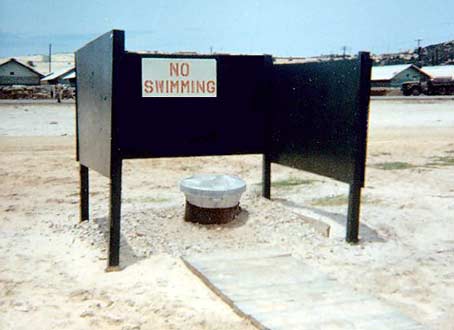 facilities
, and get some sleep before it got too hot.
facilities
, and get some sleep before it got too hot.
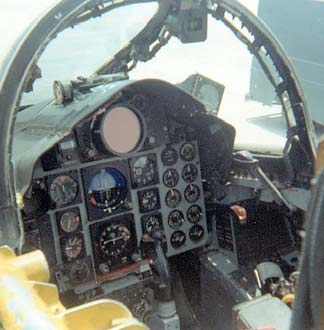
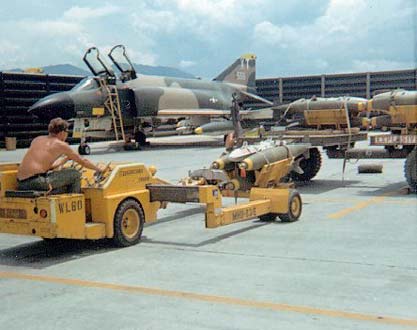 Photo Left: F-4 Phantom
being loaded with bombs. Click to see the cockpit.
Photo Left: F-4 Phantom
being loaded with bombs. Click to see the cockpit.
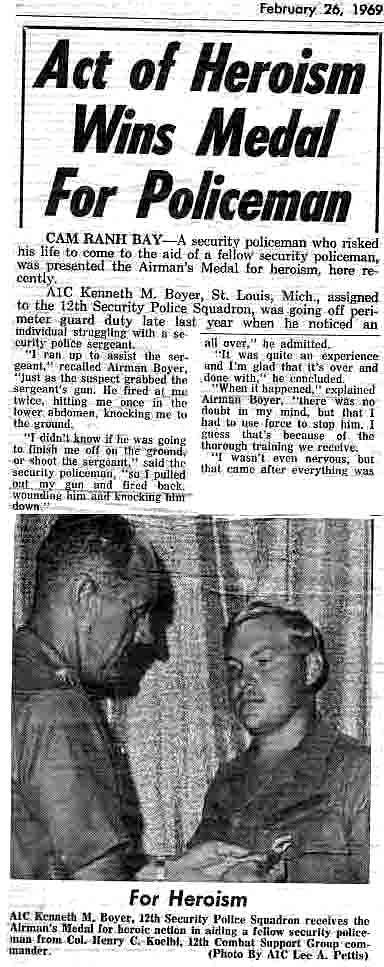 February
26, 1969 and
February
26, 1969 and 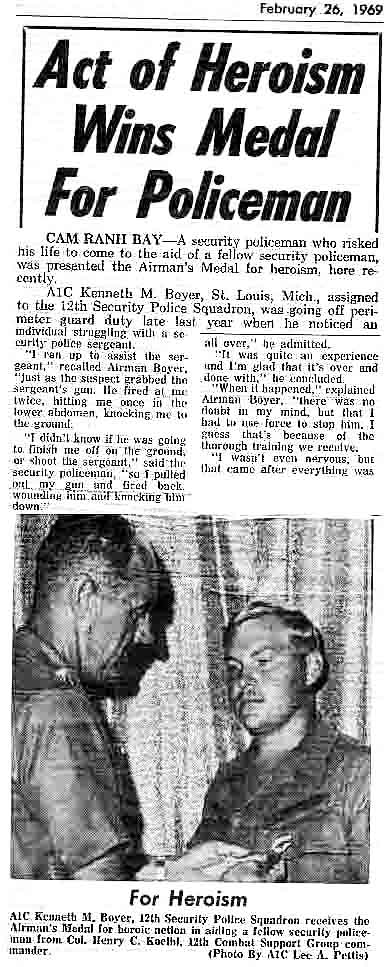 Two.
Two.